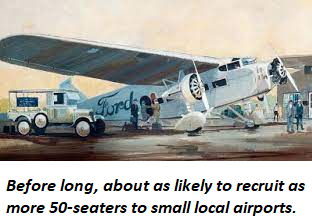Newsflash For Small Communities:
It’s A Growing Shortage of Airplanes, Not Pilots
What If We Had An Airline System And No Airplanes Showed Up?
It’s a play on an old line used in 1960s anti-Vietnam tomes.
But it’s fully appropriate in regard to the future of a lot of small community air service. New airplanes are not coming to the smaller capacity segment of the US airline system, and those now in service are being retired.
This plays directly to the need for shifts in future planning at many small airports.
The emerging reality is simple: you can’t recruit air service if there aren’t any airplanes that fit the market.
Disappearing Fleets of 50-Seaters. The fact is that the specific airplanes in major airline fleets that once – but no longer – had the economics to provide national and global connectivity for small community airports are disappearing.
Going away. Retiring. Sunning themselves in the desert. Recycling into Bud Light displays at the local supermarket.
Paying To Recreate The Past Won’t Bring It Back. Here’s a fact that tosses a monkey wrench into a lot of the supposed “marketing programs” that small communities get hornswoggled into commissioning with the goal of attracting “more flights” or “more airlines” … the  entire category of under 100 seat airliners is declining.
entire category of under 100 seat airliners is declining.
That means a lot of these expensive consultant studies may as well be looking to recruit service operated with sky hooks, Ford Trimotors and Zeppelins while they’re at it.
Pilots Or Not. The Problem Is Not In The Cockpit. There are around 425 50-seat jets still “active” in US network airline fleets. As has been seen at Texarkana, Flagstaff, Toledo and other places, they are being pulled out of fleets. American has indicated they are sidelining between 100 and 150 of these aircraft.
No, regardless of stories to the contrary, it’s lack of not pilots, per se, that’s driving these decisions. It’s the deteriorating economics of these flying machines. Airlines can’t spend expensive resources – of which pilot time is just one, on flying that loses money. Additional pilots won’t bring those routes back to life.
One Glance At The Evolving Cost Factors, And It’s Obvious. Let’s talk general cost factors.
In 1995, these 50-seat CRJs and ERJs gobbled jet fuel, adjusted for inflation, that cost 85 cents a gallon. Today the average of go juice is between $3.80 and $4.80. Like, almost five times higher.
Then there’s the natural escalation of maintenance costs. Form-41 data can be a wallow in trying to compare different metrics at different operators, but suffice it to say these airliners are experiencing the additional costs – including upgrades and occasional ADs (airworthiness directives) that come with aging.
Remember, on average the airplanes in the US 50-seat fleet are old enough to cast an absentee ballot in Wisconsin.
Let’s talk the revenue side. Average air fares since 1995 have gone up. But adjusted for inflation, they are up less than 40%. Admittedly, it’s shaky to use anything regarding “average air fares” – but apparently, take total air fare spend and dividing it by passengers, and we have a telling metric at least in regard to the revenue situation for airlines.
This does not take a Cray computer and an advanced degree in fractal geometry from MIT to figure this one out.
Darwinian Theory Is In Play. This is consistent with airline economic evolution of the last 30 years. Like the robust fleets of Metro-IIIs, Beech-1900s, S-340s, EMB-120s, J-31s, and Casa-212s that once flew around sporting major airline liveries, the viability of these 50-seaters is evaporating. Evaporating right along with the potential of the hopes of small communities being led down the airborne Primrose Path, paying for “studies” to find airliners that increasingly no longer exist.
The Airliner Cavalry Isn’t Coming. So, what about 65-seat through 76 seat airliners? Here’s another downpour on the ASD parade. There are no more of these coming, either. There are no material new orders or deliveries for <100 seat airliners in the USA airline system. (Depending on airline configuration, the new A220-100 might skirt that number – but these are mainline airliners, with mission capabilities that have little in common with E-175s and CRJ-900s.)
That means to have any snowball’s chance of success, small airport recruitment efforts must convince an airline to shift aircraft from another market.
A tough sell, particularly at communities where the majority of the locally-generated traffic is already using other airports. Or, where there simply wasn’t enough revenue to make a 50-seater work. Regardless of the size of the study and the brilliance of the compelling data provided, airline route planners don’t like taking chances.
Point: The raw costs of providing flights at local airports at small communities are eclipsing the revenue the local market can generate. That will not change, civic hubris notwithstanding.
Communities Should Be Appraised of The Truth. Small communities can commission all the “leakage studies” and “true market analyses” the local budget can pay for, and they still won’t fix the core issue, which is that increasingly, there won’t be airliners that can do the job.
Message To Media. Learn The Basics of Airline Dynamics Before Opining On Them. It is a complete falsehood to assume that small airports and their communities are on economic Death Row without scheduled air service at the local airport. Yet that’s way too often the basis of a lot of reporting on the subject.
Without going too deep into it, there recently was an incredibly ignorant article from some third-tier newspaper declaring the plight of “flyover cities” and the despair they face without having flights at the local airport. Got a lot of coverage, despite the fact that it was garbage.
The truth is that in most such cases, the consumer base has already skedaddled into using better alternative air service options. At Toledo, for example, their own studies indicated over 90% of local consumers used much more time-effective and nonstop-convenient service at Detroit, less than an hour away. In that regard, Toledo has great air access, which cannot be matched in any case at the local aerodrome.
Invest 14 Minutes & Get A Futurist Perspective. But ignoring the Cassandras in the media, there are economic and demographic  forces emerging across the USA that play well for the future for small and rural communities and their local airports, no matter whether they have commercial flights or not.
forces emerging across the USA that play well for the future for small and rural communities and their local airports, no matter whether they have commercial flights or not.
This past week, BGI’s Aviation Unscripted video series covered this topic. We go into how inflation, poor energy policy, and changing consumer spend patterns will affect traffic at specific airports and the corollary aviation-related businesses they can support.
As a key part of this, we also discuss how these factors are creating economic expansion opportunities for small communities across the nation.
Hint: certain states are working very hard to make doing business as difficult as possible. This opens opportunities for airports and communities in other parts of the nation.
Instead of spending tens of thousands on futile air service recruitment programs, there are better opportunities recruiting aviation-related firms languishing under dimbulb taxes and regulations in, say, Southern California. Or in Oregon or other like-minded progressive states.
Examples only. There are lots of potential job-creating targets of opportunity for small communities that focus on their advantages in regard to business environment and quality of life. Developing targeted programs to attract such businesses should be a priority.
The economic impact will be far greater than the distant potential of getting minimal local air service most people won’t use.
Join Us – Want some hard facts? Take a 14-minute coffee break and click here to get perspectives on the future for small airports. We’d be happy to send you the presentation deck – just hit the contact button this page and let us know.
And if you’re interested in looking to develop a futurist aviation planning program, including an aggressive outreach program focused on industry opportunities, just send us and email and we can start talking.
There is a future for small communities and their local airports. It’s just a bit different from what was expected in the past.